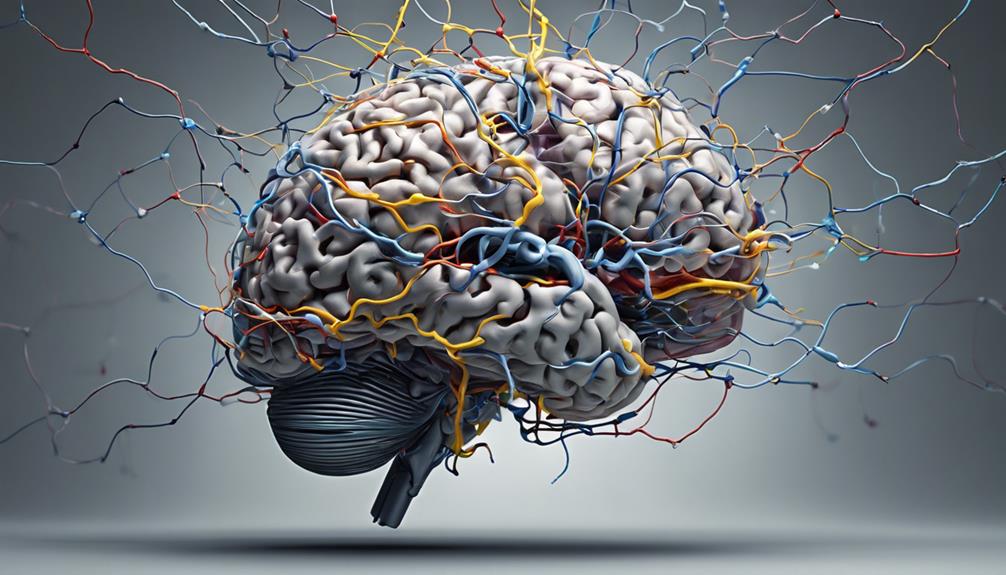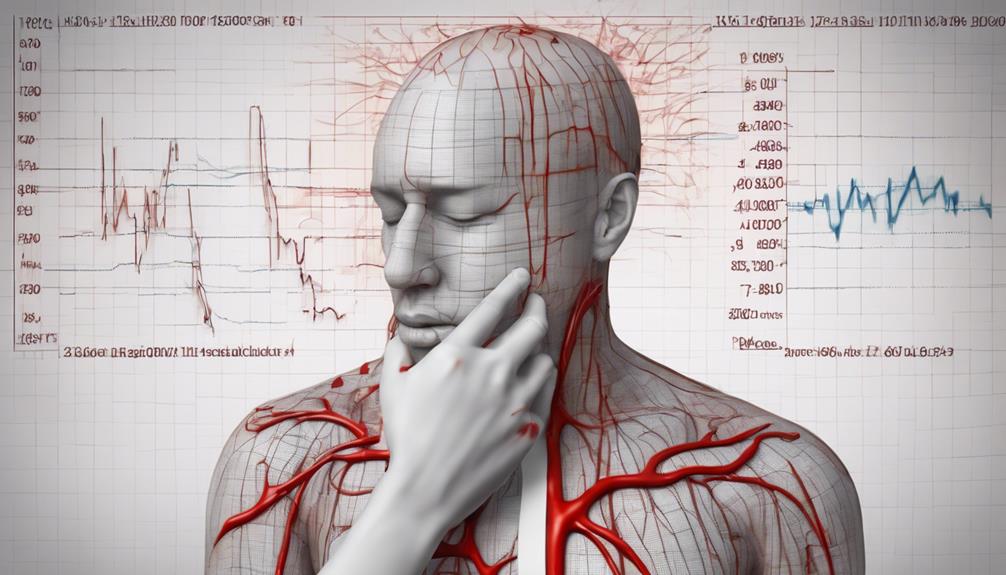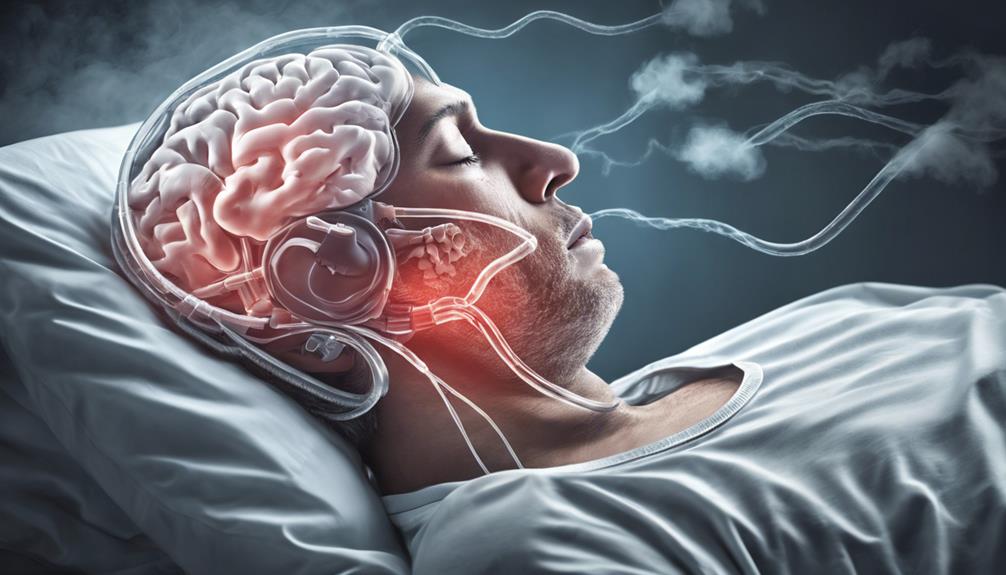When it comes to sleep apnea and headaches, there are various factors that can worsen symptoms. Sleep deprivation, low oxygen levels, and sleep disruptions all play a significant role. Inflammatory responses, neurotransmitter imbalances, and hormonal fluctuations also contribute to headaches. Brain hypoxia, muscle tension, and changes in sleep architecture are important considerations. Understanding these triggers is crucial for effective headache management. By addressing these key factors, individuals can improve control and reduce the frequency and intensity of headaches related to sleep apnea. Further exploration of each trigger can offer useful strategies for enhancing overall health.
Key Takeaways
- Oxygen desaturation from sleep apnea triggers headaches.
- Neurotransmitter imbalances affect headache severity.
- Chronic inflammation worsens headaches in sleep apnea.
- Hormonal fluctuations exacerbate headaches in sleep apnea.
- Improving sleep quality reduces headache frequency.
Sleep Deprivation
Experiencing sleep deprivation can disrupt our body's natural sleep-wake cycle, leading to an increased risk of headaches. When we don't get enough rest, our neurotransmitters and pain pathways are affected, making headaches more frequent and intense. Chronic sleep deprivation can lower our pain threshold, making us more susceptible to headaches.
To combat this issue, improving sleep quality is vital. By ensuring we've a consistent sleep schedule, creating a relaxing bedtime routine, and optimizing our sleep environment, we can enhance our sleep quality and reduce the likelihood of experiencing headaches due to lack of sleep.
Incorporating habits like limiting caffeine and screen time before bed, engaging in regular physical activity, and practicing relaxation techniques can also aid in improving our sleep quality. Remember, adequate and restful sleep is essential not only for overall health but also for minimizing the risk of headaches associated with sleep deprivation. By prioritizing quality sleep, we can better support our body's natural functions and promote overall well-being.
Oxygen Levels

When it comes to oxygen levels and sleep apnea, understanding the impact on health is essential. Low oxygen levels during sleep can lead to headaches and worsen overall well-being.
Exploring treatment options to address oxygenation issues can greatly improve the management of headaches associated with sleep apnea.
Low Oxygen Levels
Addressing low oxygen levels due to sleep apnea is vital in managing morning headaches associated with this condition.
When oxygen levels drop during sleep due to sleep apnea, blood vessels in the brain dilate, causing increased pressure within the skull. This heightened pressure can lead to morning headaches characterized by a squeezing sensation on both sides of the front of the head.
Monitoring oxygen levels during sleep is essential for understanding the impact of sleep apnea on these headaches. Proper treatment aimed at improving oxygen levels can help alleviate the headaches associated with sleep apnea.
Impact on Health
Monitoring oxygen levels during sleep provides essential insights into the impact of sleep apnea on overall health, particularly in relation to the changes in blood vessel dilation and pressure within the skull. When oxygen levels are compromised due to sleep apnea, it can have a significant effect on our health, especially with regards to headaches.
Here are three key ways how low oxygen levels can impact our health:
- Increased Headache Frequency: Decreased oxygen levels can trigger tension headaches and migraines, leading to more frequent and intense headaches.
- Risk of Cardiovascular Issues: Low oxygen levels from sleep apnea can strain the heart and increase the risk of cardiovascular problems.
- Impaired Cognitive Function: Inadequate oxygen during sleep can affect brain function, leading to cognitive issues and decreased alertness during the day.
Treatment Options
To address the impact of decreased oxygen levels in sleep apnea, treatment options focusing on improving oxygenation play an essential role in alleviating associated headaches. Monitoring oxygen levels during sleep through sleep studies can aid in diagnosing sleep apnea headaches and guiding treatment decisions.
Positive airway pressure therapy is a commonly recommended treatment that helps maintain proper oxygen levels during sleep, reducing the risk of headaches caused by oxygen deprivation. By using devices like continuous positive airway pressure (CPAP) or bilevel positive airway pressure (BiPAP), individuals with sleep apnea can effectively prevent drops in oxygen saturation levels, thereby decreasing the likelihood of experiencing headaches.
Prioritizing treatments that address oxygen levels is crucial in managing headaches associated with sleep apnea.
Sleep Disruptions

During the night, sleep disruptions caused by OSA can lead to morning headaches. These interruptions in sleep can have a significant impact on our overall well-being, especially when it comes to managing headaches.
Here are three ways sleep disruptions from sleep apnea can worsen headaches:
- Oxygen Levels: Decreased oxygen levels due to breathing difficulties during sleep can trigger morning headaches by affecting brain function and blood flow.
- Carbon Dioxide Buildup: Increased carbon dioxide levels resulting from breathing disruptions can also contribute to the development of headaches upon waking.
- Quality of Sleep: Poor sleep quality, characterized by frequent awakenings and shallow breathing patterns, can exacerbate tension headaches and migraines, making it vital to address sleep disruptions for headache management.
Understanding how sleep disruptions impact headaches is essential for effectively managing OSA-related headaches. By addressing these disruptions, individuals can work towards improving their quality of sleep and reducing the frequency and intensity of morning headaches.
Inflammatory Response

In sleep apnea, the inflammatory response triggers the release of cytokines and other inflammatory markers. This chronic inflammation can contribute to the development and severity of headaches by affecting blood vessels and nerve pathways associated with headache symptoms. Elevated levels of inflammatory markers in individuals with sleep apnea may worsen headache symptoms, making them more frequent and intense. Managing inflammation through the proper treatment of sleep apnea is vital in reducing the frequency and intensity of headaches.
| Inflammatory Response Facts | Effects on Headaches |
|---|---|
| Triggers release of cytokines | Contributes to headache development |
| Leads to chronic inflammation | Increases headache severity |
| Affects blood vessels | Worsens headache symptoms |
| Can impact nerve pathways | Raises headache frequency |
| Proper treatment reduces inflammation | Helps alleviate headache intensity |
Neurotransmitter Imbalance

Neurotransmitter imbalance in the brain plays an essential role in triggering headaches for individuals dealing with sleep apnea.
Changes in serotonin and dopamine levels can greatly impact the severity of these headaches.
Addressing these imbalances through appropriate treatment strategies is key to alleviating sleep apnea-related headaches.
Imbalance Impact on Sleep
Our understanding of how neurotransmitter imbalance impacts sleep has revealed significant insights into the relationship between sleep apnea and headaches. Imbalances in serotonin and dopamine levels can disrupt the sleep-wake cycle, contributing to the development of sleep apnea and exacerbating headaches.
Here is how neurotransmitter imbalance impacts sleep:
- Disrupted Sleep Patterns: Fluctuations in neurotransmitter levels can lead to irregular sleep patterns, worsening sleep apnea and headache symptoms.
- Altered Pain Sensitivity: Imbalances in neurotransmitters may increase pain sensitivity, making headaches more intense for individuals with sleep apnea.
- Impaired Pain Perception: Changes in neurotransmitter function can alter how the brain perceives pain, potentially amplifying headache discomfort in those with sleep apnea.
Neurotransmitters and Headaches
Exploring the impact of neurotransmitter imbalance on headaches reveals significant insights into the underlying mechanisms of headache development and severity. Imbalances in key neurotransmitters such as serotonin, dopamine, and norepinephrine can contribute to the onset and intensity of migraines and tension headaches.
Low levels of serotonin are often associated with both types of headaches, while dopamine plays a pivotal role in regulating pain perception, influencing the severity of headaches. Norepinephrine, a stress-related neurotransmitter, can act as a trigger for tension headaches.
Understanding the levels of these neurotransmitters in the body can aid in identifying potential headache triggers. By recognizing the role of neurotransmitter imbalances, individuals can better navigate the management and treatment of headaches for improved quality of life.
Treatment Options for Imbalance
Addressing imbalances in key neurotransmitters like serotonin, dopamine, and norepinephrine is essential in managing and alleviating headaches. When treating neurotransmitter imbalance related to headaches, consider the following options:
- Medications: Consult a healthcare provider for prescription medications that can help rebalance neurotransmitters and alleviate headache symptoms.
- Supplements: Certain supplements like magnesium, riboflavin (vitamin B2), and coenzyme Q10 may support neurotransmitter function and help in managing headaches.
- Lifestyle Modifications: Implement healthy lifestyle changes such as regular exercise, stress management techniques, adequate sleep, and a balanced diet rich in essential nutrients to support neurotransmitter balance and reduce headache frequency.
These strategies, when combined and tailored to individual needs, can contribute to better management of headaches associated with neurotransmitter imbalance.
Blood Pressure Changes

How do blood pressure changes in sleep apnea relate to oxygen levels and carbon dioxide levels in the body?
Blood pressure changes in sleep apnea can be influenced by oxygen desaturation and elevated carbon dioxide levels. During episodes of sleep apnea, the body may experience hypoxia, leading to an increase in blood pressure levels. This hypoxia-induced hypertension can contribute to chronic hypertension, a common condition seen in individuals with untreated sleep apnea.
The cardiovascular complications associated with elevated blood pressure highlight the importance of monitoring blood pressure regularly in individuals with sleep apnea. By managing and treating sleep apnea effectively, it's possible to regulate blood pressure and reduce the risk of cardiovascular issues. Ensuring proper monitoring of blood pressure can aid in understanding the impact of sleep apnea on cardiovascular health and guide treatment strategies to mitigate these risks.
Hormonal Fluctuations
Hormonal fluctuations impact sleep patterns and exacerbate headaches in individuals with sleep apnea. When cortisol levels are disrupted, it can lead to increased headache severity and frequency. Imbalances in hormones like melatonin and growth hormone, caused by sleep disturbances, can contribute to the intensity of headaches.
Additionally, pivotal shifts during different sleep stages play a vital role in regulating pain perception and sensitivity to headaches. Sleep disruptions from sleep apnea can disrupt the body's natural hormonal rhythms, making individuals more susceptible to headaches.
Addressing hormonal imbalances through proper sleep apnea management is essential to reducing the occurrences of headaches and improving overall well-being. By understanding the intricate relationship between hormonal fluctuations and headaches in the context of sleep apnea, individuals can take proactive steps to manage their condition effectively.
Brain Hypoxia

Experiencing brain hypoxia due to breathing disruptions in sleep apnea can lead to cognitive impairment, memory issues, and headaches. When oxygen levels in the brain are low, it can affect our ability to think clearly, remember information, and may result in frequent headaches. Here is a table summarizing the impact of brain hypoxia in sleep apnea:
| Impact of Brain Hypoxia in Sleep Apnea |
|---|
| Cognitive Impairment |
| Memory Issues |
| Headaches |
| Decreased Oxygen Levels |
| Long-term Consequences on Brain Function |
Understanding the connection between sleep apnea, brain hypoxia, and headaches is essential for managing these conditions effectively. By addressing sleep apnea through appropriate treatment, such as continuous positive airway pressure (CPAP) therapy, oxygen levels in the brain can be improved, reducing the risk of cognitive issues, memory problems, and headaches associated with brain hypoxia. Prioritizing quality sleep and seeking medical advice for sleep apnea can have a significant impact on overall well-being and cognitive function. Understanding the connection between sleep apnea, brain hypoxia, and headaches is essential for managing these conditions effectively. By addressing sleep apnea through appropriate treatment, such as continuous positive airway pressure (CPAP) therapy, oxygen levels in the brain can be improved, reducing the risk of cognitive issues, memory problems, and headaches associated with brain hypoxia. Prioritizing quality sleep and seeking medical advice for sleep apnea can have a significant impact on overall well-being and cognitive function. Additionally, timely intervention and consistent treatment not only improve quality of life but can also help prevent death from sleep apnea, a serious risk if the condition is left untreated. Raising awareness about the dangers of untreated sleep apnea and its potential complications is crucial for ensuring individuals receive the care they need to manage the disorder effectively.
Muscle Tension

Muscle tension plays a significant role in the development of headaches for individuals with sleep apnea. Tightness in the neck and head muscles can trigger tension-type headaches commonly seen in those with this sleep disorder.
Addressing muscle tension through relaxation techniques and proper sleep positioning is vital for managing these headaches effectively.
Muscle and Headaches
Feeling tightness or pressure around the head and neck area is a common indicator of muscle tension headaches. To manage these headaches effectively, consider the following:
- Identify Triggers: Recognize stressors like poor posture, jaw clenching, or prolonged computer work that may contribute to muscle tension headaches.
- Practice Relaxation Techniques: Incorporate deep breathing, progressive muscle relaxation, or yoga to release tension in the neck and head.
- Enhance Ergonomics: Guarantee proper ergonomics at workstations, use supportive pillows, and take breaks from activities that strain the neck to prevent muscle tension headaches.
Tension and Sleep Apnea
Triggered by the muscle strain and tension caused by sleep apnea, tension headaches often manifest as a steady ache or pressure around the head. Individuals with sleep apnea may experience heightened muscle tension in the head and neck area, leading to these headaches.
The disrupted sleep patterns and fluctuating oxygen levels associated with sleep apnea can contribute to the development of muscle tension headaches. These headaches are commonly described as a constant dull pain encircling the head.
Managing muscle tension through relaxation techniques and addressing the underlying sleep apnea condition can help alleviate tension headaches. By improving sleep quality and oxygen intake, individuals may experience relief from the persistent discomfort brought on by muscle tension headaches related to sleep apnea.
Sleep Architecture

Understanding the intricacies of sleep architecture is essential for evaluating sleep quality and identifying potential sleep disorders such as sleep apnea. Here are three key points to keep in mind when delving into sleep architecture:
- Stages of Sleep: Sleep architecture consists of different stages, including light sleep, deep sleep, and REM sleep. Each stage serves a unique purpose in the restoration of the body and mind during sleep.
- Disruptions: Disruptions in sleep architecture, such as frequent awakenings or breathing pauses, can greatly impact the overall quality of sleep. These interruptions can lead to daytime fatigue, cognitive impairment, and other health issues.
- Monitoring and Treatments: Understanding sleep architecture is essential in diagnosing and treating sleep disorders like sleep apnea. Monitoring changes in sleep architecture can help healthcare providers evaluate the effectiveness of sleep apnea treatments and make necessary adjustments for better sleep quality and overall well-being.
Frequently Asked Questions
What Causes Headaches With Sleep Apnea?
Headaches with sleep apnea are often caused by decreased oxygen levels and increased carbon dioxide levels in the body. Breathing disruptions during sleep apnea can lead to blood vessel dilation and increased pressure in the skull, resulting in headaches.
Morning headaches in individuals with obstructive sleep apnea are commonly linked to sleep disruptions and reduced oxygen intake. The exact cause of sleep apnea headaches isn't fully understood, but the relationship between breathing interruptions and headaches is significant.
What Is a Hypoxic Headache?
A hypoxic headache is a result of low oxygen levels in the body, often linked to conditions like sleep apnea. It triggers throbbing pain and discomfort due to insufficient oxygen reaching the brain.
Individuals with obstructive sleep apnea commonly experience these headaches upon waking. Improving oxygen intake and addressing sleep apnea are vital in alleviating these symptoms.
Proper diagnosis and treatment of sleep apnea are essential for managing hypoxic headaches effectively.
How Is Sleep Apnea Triggered?
Sleep apnea is triggered by the relaxation of throat muscles during sleep, causing airway blockages. Factors like obesity, smoking, nasal congestion, and genetics can contribute to its development.
Episodes can occur frequently, disrupting normal breathing and oxygen intake. The repeated pauses in breathing activate the body's stress response, impacting overall health.
Understanding these triggers is crucial for diagnosis and treatment to enhance quality of life.
How Do I Get Rid of a CPAP Headache?
To eliminate a CPAP headache, it is essential to take several steps:
- Make sure the mask fits properly and adjust headgear.
- Verify pressure settings with a healthcare provider for accuracy.
- Clean the mask regularly to prevent headaches from dirt.
- Experiment with various mask styles for comfort.
- Seek guidance from a sleep specialist or CPAP provider for troubleshooting.
Following these steps can effectively alleviate CPAP-related headaches and improve the overall therapy experience.
Conclusion
To sum up, it's ironic how something as essential as sleep can trigger headaches through various mechanisms. By understanding these triggers, individuals can take proactive steps to manage their sleep apnea and reduce the frequency of headaches.
Prioritizing sleep hygiene, seeking treatment for sleep apnea, and maintaining a healthy lifestyle can all contribute to improving overall well-being and reducing the impact of headaches. Remember, a good night's sleep isn't just a luxury but a necessity for peak health.









